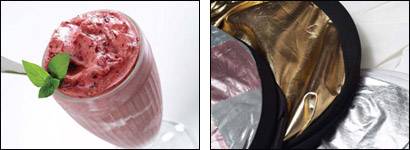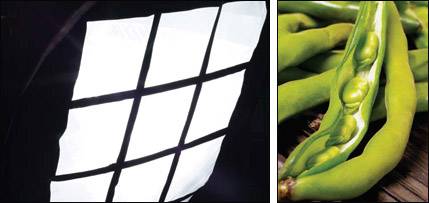Lighting for Digital Food Photography
Basic Lighting Tools: Low BudgetIf you don't have much of a budget for lighting equipment or access to any lights, you can shoot a nice photo of food utilizing window light. Use reflectors made out of aluminum foil, mirrors, white cardboard, and even the lids from takeout food containers to fill in the shadows and achieve an appetizing effect. To soften harsh shadows from direct sunlight, have a friend hold wax paper or a sheer white cloth approximately a foot above the food. Depending on how much light is coming in the window, you may need a tripod. A basic rule of thumb is to avoid handholding a camera at a shutter speed below 1/30th of a second, assuming you are using a 30mm lens. To figure out the slowest recommended shutter speed for other types of lenses, just make a fraction out of the lens's focal length in millimeters. For example, a 100mm lens shouldn't be used without a tripod at a shutter speed below 1/100th of a second. Tip Avoid using direct flash. It flattens the subject matter and doesn't make food look appetizing. Instead, try using flash fill when you shoot outdoors in sunlight to show some detail in the harsh shadows. You can also use a collapsible reflector disc to bounce sunlight back onto your subject and soften the shadows. These reflectors come in various sizes and colors. Basic Lighting Tools: Medium BudgetPortable flashes are helpful in shooting on location and can be used in a similar fashion to studio strobe units. A very simple flash lighting technique is to bounce the light off of a white card. Another is to bounce the light off of the ceiling or a wall, but be aware of the color of these surfaces; they'll influence the color of the photograph. You can use a flash extension cable that allows the flash to be away from the camera. Try placing a mini soft box or holding some diffusion material to the side of or slightly behind the food. You'll need to use some reflectors or mirrors to assist you in achieving the desired results. Of course, since you're shooting digitally, you'll get instant feedback on your lighting attempts. I often use a portable double flash technique when shooting on location. My fill flash is on a bracket over my camera or slightly off to the side. I place another flash on a stand with wheels off to the side or slightly behind the subject to get more of a three-dimensional effect. In order to set off the second flash, I use a radio slave such as the Pocket Wizard Plus with very good results. You can also utilize an optical slave depending on some factors including your budget. This is a simple technique to give dimension and depth to your image. Basic Lighting Tools: High BudgetThe use of studio strobes, umbrellas, various reflectors, soft boxes, and grid spots is truly the professional approach. There are many manufacturers and a lot of lighting equipment on the market, at all price points. Just check them out and pick one that suits your needs, budget, and use. To help you get started, I recently asked Julio at Adorama Camera's Pro Services desk what simple startup lighting packs he recommended. The Elinchrom 400BX lighting kit was his choice, and the price was right. I bought it and have been testing it with wonderful results. In addition, I've used Norman powerpacks and lights for the past 30 years. They have been reliable workhorses throughout my career. I have most of the heads, reflectors, grids, barn doors, and accessories available. |


